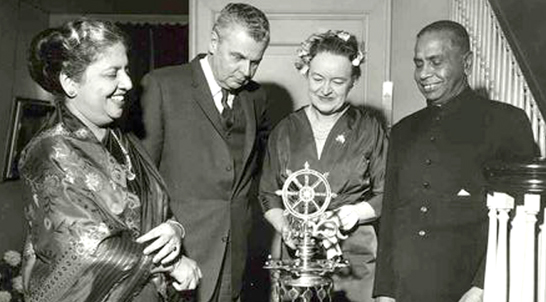Ceylon Prime Minister SWRD Bandranaike meets with Canadian External Affairs Minister Lester B. Pearson in Ottawa shortly after the resolution of the Suez Crisis in November 1956. (Duncan Cameron Collection Photo)
Ceylon and Canada forged close relations during the Suez Crisis of 1956, which split opinion among Commonwealth nations. Ceylon Prime Minister SWRD Bandaranaike was impressed by the brilliant Canadian diplomat Lester B. Pearson who masterminded a solution to end the English-French-Isreali conflict with Egypt over the Suez Canal. Ceylon, India and Pakistan feared an all-out world war as the Soviet Union threatened to defend Egypt militarily.

Fighting during the Suez Crisis.
As the crisis unfolded at the United Nations, Pearson and the Canadian delegation held meetings with representatives of South Asian nations who were opposed to the invasion of Egypt in sharp contrast to policies of Australia, New Zealand and sections Canadian public opinion which called on support for British claims over the Suez.
Pearson won the Nobel Peace Prize after he proposed the UN’s first ever peacekeeping force that would ultimately end the conflict in November 1956.
One month later, Ceylon Prime Minister SWRD Bandaranaike addressed the House of Representatives in Colombo in a speech to announce the handing over military bases from Britain to Ceylon. He said Britain still wished to use their arms dump at the naval base in Trincomalee and the oil storage facilities there and landing facilities at the air base in Katunayake. However, he made it clear these facilities could not be continued indefinitely.
“There are times when we will have to refuse them use of facilities, particularly at such times as the recent Egypitian crisis when we were not engaged in hostilities,” he told the House.
STRONGER TIES WITH CANADA

Canadian Prime Minister John Diefenbaker and his wife Olive lighting the traditional oil lamp at the Independence Day reception at the home of High Commissioner for Ceylon in Ottawa, with High Commissioner Sir Velupillai Coomaraswamy and Lady Coomaraswamy on February 4, 1960.
On the same day, the Prime Minister told the House ties with Canada would be strengthened significantly and it was matter of deep regret Ceylon does not have a diplomatic representative in Canada.

Prime Minister Diefenbaker’s wife Olive pours tea as she chats with the wife of Ceylon High Commissioner at her residence during the Independence Day reception in 1960.
In March 1958, Sri Lanka’s first High Commissioner to Canada Sir Velupillai Coomaraswamy and Lady Coomaraswamy arrived in Saint John, New Brunswick on board ocean liner RMS Empress of Britain on route to Ottawa.
In November, Canadian Prime Minister John Diefenbaker made an official visit to Ceylon with his wife. In his memoirs, Diefenbaker warned against the neutralism of Bandaranaike’s foreign policy.
A few months following the assassination of Prime Minister Bandaranaike, Diefenbaker, his wife were among 500 guests who attended Independence Day celebrations of Ceylon at the High Commissioner’s residence in Ottawa. The residence on Range Road remains the same used by Sri Lanka envoys to this day.
Speaker of the Senate, Secretary of State for External Affairs, Minister of Finance, Minister of National Health, Minister of Justice , Mayor of Ottawa and their spouses were among the guests at the Independence Day celebrations at the High Commissioner’s residence in 1960.
Prime Minister Diefenbaker’s wife and the cabinet ministers’ wives were among the tea pourers. The buffet dinner included, string hopper pilau with shrimp and meat curries.
